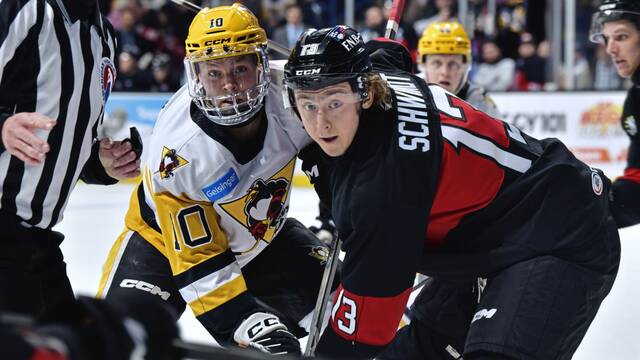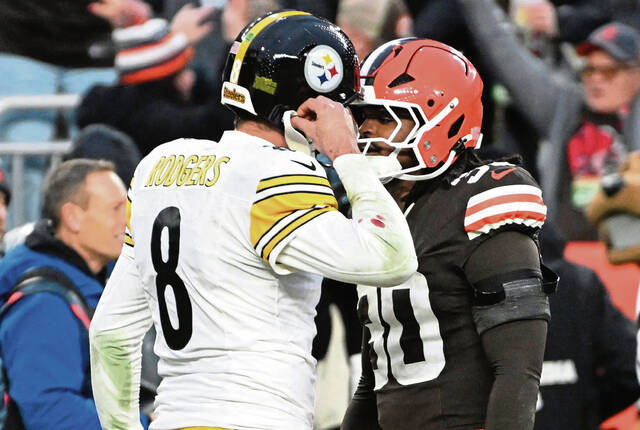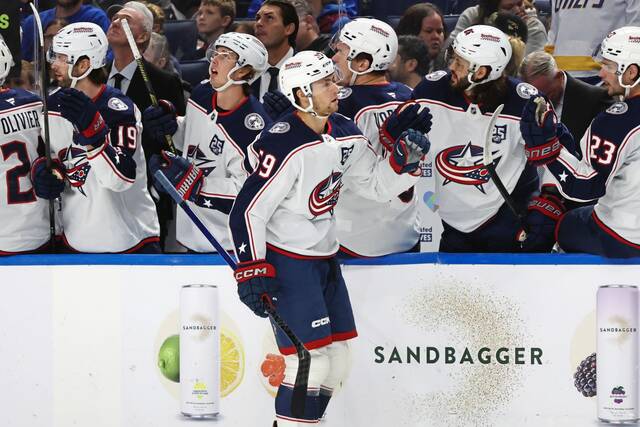Five stats-based observations about the Pittsburgh Penguins’ 5-3 loss in Game 5 on Wednesday that pulled the New York Rangers to within a game of evening the team’s first-round playoff series:
1. E-Rod time
Evan Rodrigues was something of an odd man left out after Sidney Crosby’s injury during Game 5. Coach Mike Sullivan’s general strategy for replacing Crosby (from a lineup perspective) was simple: bump up each of the other three centers to play with the previously paired wings.
That left fourth-line wingers Rodrigues and Brian Boyle without a center — and therefore, without much ice time. Not counting a skate playing out the proverbial string over the final 16 seconds following New York’s empty-net goal sealed the result, Boyle had only three even-strength shifts in the 26 minutes, 50 seconds after Crosby left the game.
But Rodrigues took 10 overall shifts (eight at even strength) in the 1⅓ periods of play after the Crosby injury. Most notably, Rodrigues was with the top power-play unit, and he was deployed in the 6-on-5 with the goalie pulled at the end of regulation. Both show that Sullivan views Rodrigues as the proverbial “next man up” in offensive situations.
Measured by shot-attempt metrics, Rodrigues was the Penguins’ best possession player at even strength (68.4%) in Game 5. He also led the team in even-strength expected goals-for percentage (85.6).
Wednesday was no fluke. Rodrigues leads all Penguins forwards in the series in attempted shots percentage for his team relative to the opponent at even strength (59.5%). He trails only Crosby and usual linemates Bryan Rust and Jake Guentzel in expected goals-for percentage.
2. Louis, Louis
The traditional statistics aren’t overwhelming for Louis Domingue. Among the 16 goalies who have appeared in at least three games this postseason, Domingue’s goals-against average (3.56) ranks 12th and his save percentage (.900) is 13th.
Domingue’s .901 even-strength save percentage and 3.45 goals-against average for the postseason both ranked 14th among 15 NHL goalies who had played at least 120 minutes during these playoffs.
Interestingly, Domingue has been league-average in making what are deemed to statistically be the most difficult saves. His .852 save percentage on “high-danger scoring chances” is right in the middle of goalies during these playoffs (eighth among 15).
The least-flattering metric to Domingue? Perhaps the most in-depth and all-inclusive. In goals saved above average, Domingue is minus-2.46. That’s worse than the Rangers’ widely ridiculed goalie in this series, Igor Shesterkin. Shesterkin’s is minus-1.76, second-worst in the NHL during these playoffs.
A goaltending clinic, this series has not been.
3. Probable wins
The eye test suggested the Penguins were controlling the play throughout much of Game 5. The scoreboard, through 1¾ periods, read 2-0 as well.
The math agrees, too. Moneypuck.com calculates in-game “win probability.” For the Penguins, it peaked at 88% Wednesday.
Of course, things quickly changed when New York scored thrice over a span of 2 minutes, 42 seconds, falling, in succession to 74%, then 50% and — briefly — 25% before Jake Guentzel’s second goal of the game tied it at 3.
The good news, according to Money Puck? The Penguins still have an 86% chance of winning the series. That is based in part on that the site’s analytics say the Penguins had the overall better of the overall play Wednesday — albeit by the smallest margin (0.44 expected goals) of any game in the series.
The combined expected goals in all situations in this series is 26.5-15.4, a decisive edge for the Penguins and an illustration that they “deserve” to win the series.
4. Lead changes
The script has been flipped since the most recent time this space calculated game time during which each team held a lead or it was tied.
Through two games in the series, the Penguins did not play one second with a lead. Each of the past three games, though, the majority of play took place with the Penguins in the lead. Fifty-seven percent of Games 3-5 were played while the Penguins were ahead, 28% was with score tied and 14.7% was when New York was winning.
5. Bad Game 5s
Wednesday’s defeat means the Penguins have lost eight of the past 11 in a Game 5 of a series while holding a 3-1 series lead. Twice in that time, they went on to lose the series — including to the Rangers in the 2014 second round.
Also of note Wednesday: the Rangers overcame a multi-goal deficit to stave off elimination for the fourth time in franchise history.








